Disrupted modularity and local connectivity of brain functional networks in childhood-onset schizophrenia
- PMID: 21031030
- PMCID: PMC2965020
- DOI: 10.3389/fnsys.2010.00147
Disrupted modularity and local connectivity of brain functional networks in childhood-onset schizophrenia
Abstract
Modularity is a fundamental concept in systems neuroscience, referring to the formation of local cliques or modules of densely intra-connected nodes that are sparsely inter-connected with nodes in other modules. Topological modularity of brain functional networks can quantify theoretically anticipated abnormality of brain network community structure - so-called dysmodularity - in developmental disorders such as childhood-onset schizophrenia (COS). We used graph theory to investigate topology of networks derived from resting-state fMRI data on 13 COS patients and 19 healthy volunteers. We measured functional connectivity between each pair of 100 regional nodes, focusing on wavelet correlation in the frequency interval 0.05-0.1 Hz, then applied global and local thresholding rules to construct graphs from each individual association matrix over the full range of possible connection densities. We show how local thresholding based on the minimum spanning tree facilitates group comparisons of networks by forcing the connectedness of sparse graphs. Threshold-dependent graph theoretical results are compatible with the results of a k-means unsupervised learning algorithm and a multi-resolution (spin glass) approach to modularity, both of which also find community structure but do not require thresholding of the association matrix. In general modularity of brain functional networks was significantly reduced in COS, due to a relatively reduced density of intra-modular connections between neighboring regions. Other network measures of local organization such as clustering were also decreased, while complementary measures of global efficiency and robustness were increased, in the COS group. The group differences in complex network properties were mirrored by differences in simpler statistical properties of the data, such as the variability of the global time series and the internal homogeneity of the time series within anatomical regions of interest.
Keywords: brain; clustering; fMRI; graph theory; modularity; network; schizophrenia.
Figures

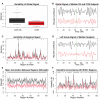
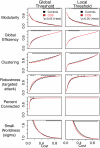

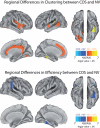
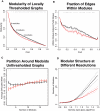
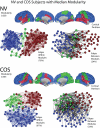

Similar articles
-
The anatomical distance of functional connections predicts brain network topology in health and schizophrenia.Cereb Cortex. 2013 Jan;23(1):127-38. doi: 10.1093/cercor/bhr388. Epub 2012 Jan 23. Cereb Cortex. 2013. PMID: 22275481 Free PMC article.
-
Modular and hierarchically modular organization of brain networks.Front Neurosci. 2010 Dec 8;4:200. doi: 10.3389/fnins.2010.00200. eCollection 2010. Front Neurosci. 2010. PMID: 21151783 Free PMC article.
-
Functional brain network modularity captures inter- and intra-individual variation in working memory capacity.PLoS One. 2012;7(1):e30468. doi: 10.1371/journal.pone.0030468. Epub 2012 Jan 20. PLoS One. 2012. PMID: 22276205 Free PMC article. Clinical Trial.
-
Binary and weighted network analysis and its applications to functional connectivity in subjective memory complaints: A resting-state fMRI approach.Ageing Res Rev. 2025 Apr;106:102688. doi: 10.1016/j.arr.2025.102688. Epub 2025 Feb 11. Ageing Res Rev. 2025. PMID: 39947486 Review.
-
Working memory performance of early MS patients correlates inversely with modularity increases in resting state functional connectivity networks.Neuroimage. 2014 Jul 1;94:385-395. doi: 10.1016/j.neuroimage.2013.12.008. Epub 2013 Dec 19. Neuroimage. 2014. PMID: 24361662 Review.
Cited by
-
Network Controllability in Transmodal Cortex Predicts Positive Psychosis Spectrum Symptoms.Biol Psychiatry. 2021 Sep 15;90(6):409-418. doi: 10.1016/j.biopsych.2021.03.016. Epub 2021 Mar 21. Biol Psychiatry. 2021. PMID: 34099190 Free PMC article.
-
Nicotine increases brain functional network efficiency.Neuroimage. 2012 Oct 15;63(1):73-80. doi: 10.1016/j.neuroimage.2012.06.079. Epub 2012 Jul 14. Neuroimage. 2012. PMID: 22796985 Free PMC article. Clinical Trial.
-
Small world properties of schizophrenia and OCD patients derived from fNIRS based functional brain network connectivity metrics.Sci Rep. 2024 Oct 16;14(1):24314. doi: 10.1038/s41598-024-72199-0. Sci Rep. 2024. PMID: 39414848 Free PMC article.
-
Brain anomaly networks uncover heterogeneous functional reorganization patterns after stroke.Neuroimage Clin. 2018 Aug 12;20:523-530. doi: 10.1016/j.nicl.2018.08.008. eCollection 2018. Neuroimage Clin. 2018. PMID: 30167372 Free PMC article.
-
Habenula-prefrontal resting-state connectivity in reactive aggressive men - A pilot study.Neuropharmacology. 2019 Sep 15;156:107396. doi: 10.1016/j.neuropharm.2018.10.025. Epub 2018 Oct 23. Neuropharmacology. 2019. PMID: 30366001 Free PMC article.
References
-
- Anderson B., Butts C., Carley K. (1999). The interaction of size and density with graph-level indices. Soc. Networks 21, 239–26710.1016/S0378-8733(99)00011-8 - DOI
Grants and funding
LinkOut - more resources
Full Text Sources

